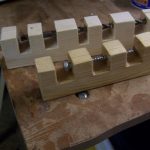We may receive a commission when you use our affiliate links. However, this does not impact our recommendations.

This week I’ll be taking a sack back Windsor chair class with maestro Michael Dunbar at The Windsor Institute, his school in Hampton, New Hampshire (a state my daughter has re-named “New Hampster”).
This is my third chair class. I took my first one in Canada with David Fleming. My second class was with bodger Don Weber. And at long last, I have made it here for a class.
You are probably asking yourself this question: Why am I reading the blog of a guy who is so dense that he has to take a class three times? That’s like flunking kindergarten. Twice (I think).
For those of you still reading this, the answer is that chairmaking is one of my hobbies. I’ve made most of the chairs in my house, and I am fascinated by the different ways of building the same Windsor-style chair.
Windsor chairs, unlike Shaker chairs or frame chairs (such as Morris chairs) derive their strength from the seat. The legs are tenoned into the seat, as are the spindles of the chair. To me they are an interesting challenge in geometry and engineering. And they involve entirely different parts of my brain than when I am building casework. In many ways, chairs require both more and less precision than casework. If you’ve ever built one, you know what I mean.
This isn’t my first visit to Dunbar’s school, however. I’ve been up here to shoot photos for his articles in Popular Woodworking Magazine. And, in fact, I’m shooting photos for two article on Sunday before the class begins. (No, Asa, I won’t tell you what the stories are about).
During these earlier photo shoots, I’ve always felt a pang of desire when I walked into the school, which is a beautiful space. This week, I get to strangle that pang.
Dunbar’s chairmaking techniques are different than those of my previous two teachers. Fleming was almost entirely a hand-tool guy. Springpole lathe. Brace and bit. Hatchet. And we started from the stump. With Weber, I got to learn steam bending and his tricks for turning spindles on an electric lathe. And I’m greatly looking forward to soaking up Dunbar’s decades of wisdom.
– Christopher Schwarz
Other Chair Resources I Recommend
– Visit Don Weber’s web site (handcraftwoodworks.com)
– “Chairmaking Simplified” by Kerry Pierce
– Country Workshops, a chairmaking school in North Carolina (countryworkshops.org)

Here are some supplies and tools we find essential in our everyday work around the shop. We may receive a commission from sales referred by our links; however, we have carefully selected these products for their usefulness and quality.








Chris — you have to let us know when you’re going to take a class (the same as when you’re offering one!) I’d have loved to come and take this class along with you — learning from one great and pestering another with all my questions 😉
Hey, Chris. Good for you. You will be learning from the best. I have been there six times, and want to get back as soon as I am able. One of the real challenges is getting your chair back home. I wrapped my Sack Back in about 200 yards of plastic wrap (chair "necked" as Jay bird underneath) and counted it as my second bag. When I went to pick it up, the baggage claim folks said it might have ended up in toothpicks had they not been able to see what it was. Have fun, and please tell Mike I said hello.
Joel Jackson
San Antonio, TX